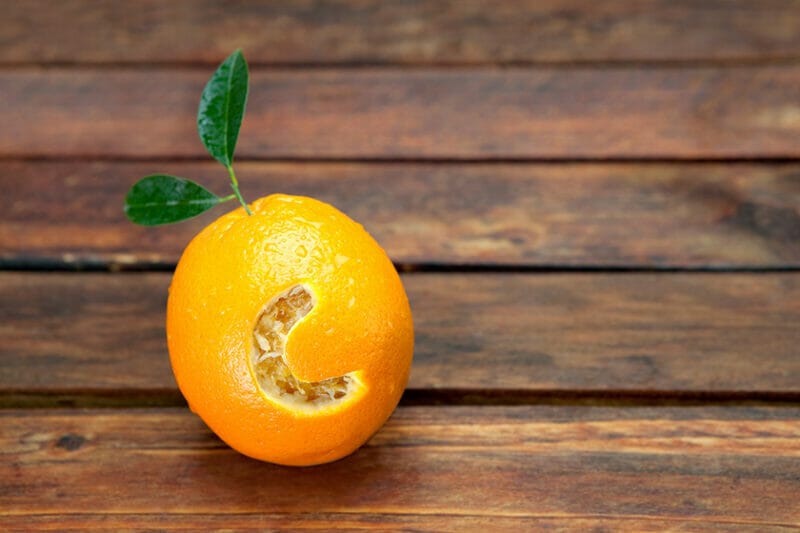 Vitamin C (or L-ascorbic acid, hereafter referred to as VitC) is a nutrient with a six-carbon structure, synthesised from glucose, abundant in fruits, vegetables and the kidney and liver of most animals. VitC is a potent water-soluble antioxidant that is produced in most mammals but is not endogenously synthesised in humans, who lack enzymes for its synthesis.[1] Hence we need to consume it to avoid deficiency-related diseases.
Vitamin C (or L-ascorbic acid, hereafter referred to as VitC) is a nutrient with a six-carbon structure, synthesised from glucose, abundant in fruits, vegetables and the kidney and liver of most animals. VitC is a potent water-soluble antioxidant that is produced in most mammals but is not endogenously synthesised in humans, who lack enzymes for its synthesis.[1] Hence we need to consume it to avoid deficiency-related diseases.
Many animals can synthesise their own vitamin C. The researchers Axel Holst and Theodor Frölich fortuitously produced scurvy in the guinea pig, which like humans requires vitamin C in their diet. In 1928, Albert Szent-Györgyi isolated a substance from adrenal glands that he called ‘hexuronic acid’. Four years later, Charles Glen King isolated vitamin C in his laboratory and concluded that it was the same as ‘hexuronic acid’. Norman Haworth deduced the chemical structure of vitamin C in 1933.[2]
Scurvy
The best-known deficiency disease is ‘scurvy’, resulting from prolonged vitamin C deficiency. It had its nomenclature origins in ‘scorbutus’ (Latin), ‘scorbut’ (French), and ‘Skorbut’ (German). Scurvy was once a common problem in the world’s navies and is estimated to have affected 2 million sailors. In 1747, James Lind conducted a trial of six different treatments for 12 sailors with scurvy: only oranges and lemons were effective in treating scurvy. Scurvy also occurred on land, as many cases occurred with the ‘great potato famine’ in Ireland in 1845.
Whilst most nutritionists are unlikely to see scurvy presenting in clinic, despite its recent doubling in incidences since 2010-11, from 82 to 171 in 2020-21, it is easily corrected through the supplementation of ascorbic acid.
Mood
Interestingly, vitamin C presents its highest concentrations in the brain, and animal models and in vitro studies have reported that vitamin C performs a critical role in brain function.[3] Classically, vitality decline is known is the earliest sign of scurvy, a clinical symptom of severe vitamin C deficiency.
It seems that mental vitality which included fatigue, attention, work engagement, self-control resources, and measured mood status, including stress, depression, positive and negative affect, and anxiety in healthy young adults is enhanced by the ingestion of 1000mg VitC daily. The group that benefitted the most were those deemed to have a shortfall in VitC, which is more common than may be thought. Inadequate vitamin C status is prevalent among young adults even in industrialised countries.[4] The poor vitamin C status in this demographic can be attributed to external factors such as smoking, excessive drinking, and unhealthy eating habits that fail to provide a fresh and balanced diet rich in VitC. Dopaminergic signalling enhancement is the suggested mechanism for this cheap, safe and easy-to-employ nutrient.[5]
Cancer
The concept of utilising VitC as a therapeutic agent for cancer care was first introduced by double Nobel Prize-winning chemist Linus Pauling and physician Ewan Cameron in the 1970s.[6]
Mounting evidence indicates that vitamin C has the potential to be a potent anti-cancer agent when administered intravenously and in high doses (high-dose IVC). Early phase clinical trials have confirmed the safety and indicated the efficacy of IVC in eradicating tumour cells of various cancer types.
In recent years, the multi-targeting effects of vitamin C were unravelled, demonstrating a role as a cancer-specific, pro-oxidative cytotoxic agent, anti-cancer epigenetic regulator and immune modulator, reversing epithelial-to-mesenchymal transition, inhibiting hypoxia and oncogenic kinase signalling and boosting immune response.[7]
An important distinction must be made between orally administered VitC, achieving maximum plasma concentrations of no more than 220 μmol/L of blood, and pharmacological or high-dose IVC, generating plasma concentrations up into the millimolar range (≥ 15 mmol/L), which is needed to kill cancer cells based on pre-clinical studies.[8]High-dose intravenous ascorbate and its derivatives have the potential to deliver favourable and economical anticancer therapeutic opportunities that should be further explored. Due to their ready availability in nature, low toxicity, and low cost, ascorbic acid and its derivatives could become important therapeutic options in the battle against cancer.[9]

Viral Infection
Since the novel coronavirus (SARS-CoV-2) and the associated disease (COVID-19) were declared a global pandemic in early 2020, there has been a worldwide effort to establish therapies to prevent and treat respiratory infection and more severe diseases. VitC plays a vital role in the proper functioning of the immune system. Its concentration in immune cells (lymphocytes, monocytes, and neutrophils) in individuals consuming ≥100 mg ascorbate per day is up to 100 times higher than plasma concentrations.[10] Whilst there are variations in outcomes of infection and other aspects of VitC related therapeutics, in part likely due to the role of slc23 and slc2 family of genes’ polymorphism and expression as the essential factors affecting the uptake and regulation of ascorbic acid levels in organisms.[11]
To date, studies have indicated variable effects on the risk of SARS-CoV-2 and other upper respiratory tract infections with oral vitamin C, unless the person is under enhanced stress. However, there is evidence that vitamin C can attenuate the duration and severity of respiratory and SARS-CoV-2 infections, thus potentially preventing progression to more severe conditions such as pneumonia, ARDS, sepsis and COVID-19.[12]
Reflections
VitC has been through periods of optimism and pessimism, but what is clear is that it is an essential nutrient and when utilised correctly impacts multiple pathways that support health generation. Of interest is the relationship with VitC and mood, especially amongst young adults, who post COVID-19 related activities, appear to be struggling with many mental health challenges.
As Dr Sachs, the lead author in the September 2022 Lancet COVID-19 Commission on the global response to the pandemic, points out. Now is the time to take collective action that promotes public health and sustainable development to bring an end to the pandemic, addresses global health inequities, protects the world against future pandemics, identifies the origins of this pandemic, and builds resilience for communities around the world.
The Commission shows that national governments were too slow and too cautious in their response to the outbreak of SARS-CoV-2. They paid too little attention to the most vulnerable groups in society. Their responses were hampered by low public trust and an epidemic of misinformation and disinformation.
Let us hope that as a greater understanding of the importance of lifestyle and nutrients are becoming better known that any future event will recognise the importance, safety and viability of nutrients such as Vitamin C.[13]
References
[1] Nishikimi M, Fukuyama R, Minoshima S, Shimizu N, Yagi K. Cloning and chromosomal mapping of the human nonfunctional gene for L-gulono-gamma-lactone oxidase, the enzyme for L-ascorbic acid biosynthesis missing in man. J Biol Chem. 1994 May 6;269(18):13685-8
[2] Carpenter KJ. The discovery of vitamin C. Ann Nutr Metab. 2012;61(3):259-64
[3] Harrison FE, May JM. Vitamin C function in the brain: vital role of the ascorbate transporter SVCT2. Free Radic Biol Med. 2009 Mar 15;46(6):719-30. doi: 10.1016/j.freeradbiomed.2008.12.018. Epub 2009 Jan 6
[4] Schleicher RL, Carroll MD, Ford ES, Lacher DA. Serum vitamin C and the prevalence of vitamin C deficiency in the United States: 2003-2004 National Health and Nutrition Examination Survey (NHANES). Am J Clin Nutr. 2009 Nov;90(5):1252-63. doi: 10.3945/ajcn.2008.27016. Epub 2009 Aug 12. PMID: 19675106
[5] Sim M, Hong S, Jung S, Kim JS, Goo YT, Chun WY, Shin DM. Vitamin C supplementation promotes mental vitality in healthy young adults: results from a cross-sectional analysis and a randomized, double-blind, placebo-controlled trial. Eur J Nutr. 2022 Feb;61(1):447-459
[6] Cameron E, Pauling L. Supplemental ascorbate in the supportive treatment of cancer: Prolongation of survival times in terminal human cancer. Proc Natl Acad Sci U S A. 1976 Oct;73(10):3685-9
[7] Böttger F, Vallés-Martí A, Cahn L, Jimenez CR. High-dose intravenous vitamin C, a promising multi-targeting agent in the treatment of cancer. J Exp Clin Cancer Res. 2021 Oct 30;40(1):343
[8] Stephenson CM, Levin RD, Spector T, Lis CG. Phase I clinical trial to evaluate the safety, tolerability, and pharmacokinetics of high-dose intravenous ascorbic acid in patients with advanced cancer. Cancer Chemother Pharmacol. 2013 Jul;72(1):139-46. doi: 10.1007/s00280-013-2179-9
[9] Reang J, Sharma PC, Thakur VK, Majeed J. Understanding the Therapeutic Potential of Ascorbic Acid in the Battle to Overcome Cancer. Biomolecules. 2021 Jul 31;11(8):1130
[10] Mousavi S, Bereswill S, Heimesaat MM. Immunomodulatory and Antimicrobial Effects of Vitamin C. Eur J Microbiol Immunol (Bp). 2019 Aug 16;9(3):73-79
[11] Grudlewska-Buda K, Wiktorczyk-Kapischke N, Budzyńska A, Kwiecińska-Piróg J, Przekwas J, Kijewska A, Sabiniarz D, Gospodarek-Komkowska E, Skowron K. The Variable Nature of Vitamin C-Does It Help When Dealing with Coronavirus? Antioxidants (Basel). 2022 Jun 24;11(7):1247
[12] Carr AC, Gombart AF. Multi-Level Immune Support by Vitamins C and D during the SARS-CoV-2 Pandemic. Nutrients. 2022 Feb 6;14(3):689
[13] Holford P, Carr AC, Zawari M, Vizcaychipi MP. Vitamin C Intervention for Critical COVID-19: A Pragmatic Review of the Current Level of Evidence. Life (Basel). 2021 Nov 1;11(11):1166
